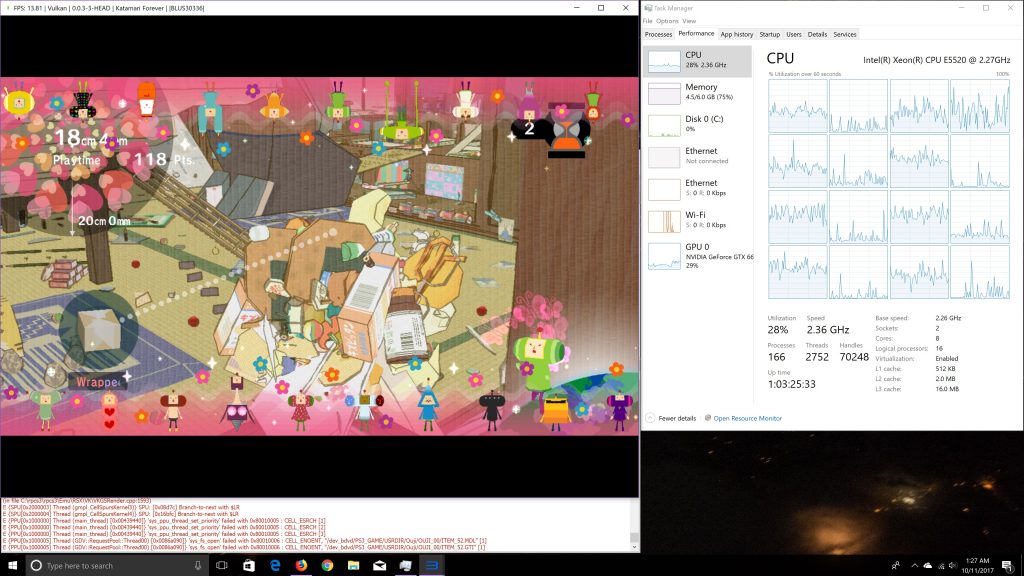I showed some iterations of ScriptinScript’s proposed object value representation, using native JS objects with a custom prototype chain to isolate the guest world’s JS objects. The more I looked I saw more corner cases… I thought of the long list of security issues with the old Caja transpiling embedding system, and decided it would be best to change course.
Not only are there a lot of things to get right to avoid leaking host objects, it’s simply a lot of work to create a mostly spec-compliant JavaScript implementation, and then to maintain it. Instead I plan to let the host JavaScript implementation run almost the entire show, using realms.
What’s a Realm?
Astute readers may have clicked on that link and noticed that the ECMAScript committee’s realms proposal is still experimental, with no real implementations yet… But realms are actually a part of JS already, there’s just no standard way to manipulate them! Every function is associated with a realm that it runs in, which holds the global object and the intrinsic objects we take for granted — say, Object. Each realm has its own instance of each of these instrinsics, so if an object from one realm does make its way to another realm, their prototype chains will compare differently.
That sounds like what we were manually setting up last time, right? The difference is that when native host operations like throwing exceptions in a built-in function, auto-boxing a primitive value to an object, etc happen, the created Error or String etc instance will have the realm-specific prototype without us having to guard for it and switch it around.
If we have a separate realm for the guest environment, then there are a lot fewer places we have to guard against getting host objects.
Getting a realm
There are a few possible ways we can manage to get ahold of a separate realm for our guest code:
- Un-sandboxed <iframe>
- Sandboxed <iframe>
- Web Worker thread
- ‘vm’ module for Node.js
It should be possible to combine some of these techniques, such as using the future-native Realm inside a Worker inside a sandboxed iframe, which can be further locked down with Content-Security-Policy headers!
Note that using sandboxed or cross-origin <iframe>s or Workers requires asynchronous messaging between host and guest, but is much safer than Realm or same-origin <iframe> because they prevent all object leakage.
Similar techniques are used in existing projects like Oasis to seeming good effect.
Keep it secret! Keep it safe!
To keep the internal API for the guest environment clean and prevent surprise leakages to the host realm, it’s probably wise to clean up the global object namespace and the contents of the accessible intrinsics.
This is less important if cross-origin isolation and Content-Security-Policy are locked down carefully, but probably still a good idea.
For instance you probably want to hide some things from guest code:
- the global message-passing handlers for postMessage to implement host APIs
- fetch and XMLHttpRequest for network access
- indexedDB for local-origin info
- etc
In an <iframe> you would probably want to hide the entire DOM to create a fresh realm… But if it’s same-origin I don’t quite feel confident that intrinsics/globals can be safely cleaned up enough to avoid escapes. I strongly, strongly recommend using cross-origin or sandboxed <iframe> only! And a Worker that’s loaded from an <iframe> might be best.
In principle the realm can be “de-fanged” by walking through the global object graph and removing any property not on an allow list. Often you can also replace a constructor or method with an alternate implementation… as long as its intrinsic version won’t come creeping back somewhere. Engine code may throw exceptions of certain types, for instance, so they may need pruning in their details as well as pruning from the global tree itself.
In order to provide host APIs over postMessage, keep local copies of the global’s postMessage and addEventListener in a closure and set them up before cleaning the globals. Be careful in the messaging API to use only local variable references, no globals, to avoid guest code interfering with the messaging code.
Whither transpiling?
At this point, with the host environment in a separate realm *and* probably a separate thread *and* with its globals and intrinsics squeeky clean… do we need to do any transpiling still?
It’s actually, I think, safe at that point to just pass JS code for strict mode or non-strict-mode functions in and execute it after the messaging kernel is set up. You should even be able to create runtime code with eval and the Function constructor without leaking anything to/from the host context!
Do we still even need to parse/transpile? Yes!
But the reason isn’t for safety, it’s more for API clarity, bundling, and module support… Currently there’s no way to load JS module code (with native import/export syntax) in a Worker, and there’s no way to override module URL-to-code resolution in <script type=”module”> in an <iframe>.
So to support modern JS modules for guest code, you’d need some kind of bundling… which is probably desired anyway for fetching common libraries and such… and which may be needed to combine the messaging kernel / globals cleanup bootstrap code with the guest code anyway.
There’s plenty of prior art on JS module -> bundle conversion, so this can either make use of existing tools or be inspired by it.
Debugging
If code is simply executed in the host engine, this means two things:
One, it’s hard to debug from within the web page because there aren’t tools for stopping the other thread and introspecting it.
Two, it’s easy to debug from within the web browser because the host debugger Just Works.
So this is probably good for Tools For Web Develepers To Embed Stuff but may be more difficult for Beginner’s Programming Tools (like the BASIC and LOGO environments of my youth) where you want to present a slimmed-down custom interface on the debugger.
Conclusions
Given a modern-browser target that supports workers, sandboxed iframes, etc, using those native host tools to implement sandboxing looks like a much, much better return on investment than continuing to implement a full-on interpreter or transpiler for in-process code.
This in some ways is a return to older plans I had, but the picture’s made a LOT clearer by not worrying about old browsers or in-process execution. Setting a minimal level of ES2017 support is something I’d like to do to expose a module-oriented system for libraries and APIs, async, etc but this isn’t strictly required.
I’m going to re-work ScriptinScript in four directions:
First, the embedding system using <iframe>s and workers for web or ‘vm’ for Node, with a messaging kernel and global rewriter.
Second, a module bundling frontend that produces ready-to-load-in-worker JS, that can be used client-side for interactive editing or server-side for pre-rendering. I would like to get the semantics of native JS modules right, but may approximate them as a simplification measure.
Third, a “Turtle World” demo implementing a much smaller interpreter for a LOGO-like language, connected to a host API implementing turtle graphics in SVG or <canvas>. This will scratch my itch to write an interpreter, but be a lot simpler to create and maintain. ;)
Finally, a MediaWiki extension that allows storing the host API and guest code for Turtle World in a custom wiki namespace and embedding them as media in articles.
I think this is a much more tractable plan, and can be tackled bit by bit.

